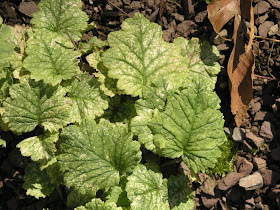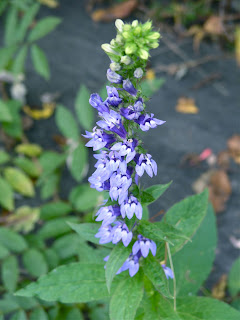On Saturday, Doc took us to a matinee of Aida, at the Metropolitan Opera. It happened to coincide with the date, October 24, for international climate action set by 350.org. Rather than miss the opera to attend an event, I decided at the last minute to make my own. So, I had some flyers printed up about the perils of climate change, and distributed them on the Lincoln Center Plaza before the performance.
I was promptly informed by a policeman that I was permitted to do no such thing; so instead, I haunted the sidewalk out front and had only one refusal, from a gentleman who claimed he's "hopeless" when it comes to clean energy, because he works for the US Chamber of Commerce!
Ha ha, I said, you guys really got punked this week, didn't you!? And to give him credit, he laughed rather sheepishly. Here is background if you missed the story!
Aida ends when the star-crossed lovers - she a princess of Ethiopia, and Radames, the highest military leader of Egypt - give up their lives rather than betray their respective country's animosity, led not inconsequentially, by the high priests (see the Church of the Flying Spaghetti Monster for more details on that sort of idiocy). Actually, Aida has an incredibly beautiful aria in Act 4 about her desire to go back to Ethiopia, a land of bounty and beauty, a wealth of ecological diversity, a glorious preserve of nature.
Irony, anyone?
In the last act, the doomed pair sing in an achingly touching duo, weeping in poetic grief and despair, when they are entombed together, literally buried alive, beneath the weight of their society's ignorance, hate, stupidity, and irrationality.
Oh, could that be some kind of prophetic presage?
Doc doesn't like the whole negativity thing - in fact he hated the ocean video when I showed it to him - (and I didn't even bother to point out that the main take-away point, only briefly touched upon in the narration, is that most of the oxygen people breathe is produced by life in the oceans!) - but in the end, he helped to hand out the leaflets. Thanks, Doc! He's wearing his cool Italian bike-racing glasses - hey, not too shabby to be a mad bicyclist at 82.
Last week, on Wednesday, October 21, I had the pleasure to visit another very special arboretum. Buck Gardens was donated to the public by a very prominent family because it is a very special location, comprising a deep valley which was forged eons ago by a glacier. It is a small park that has very steep rock walls, and a tiny stream cutting through the center. Although not particularly extensive, it is sweet. The staff and volunteers have created and maintained a spectacular series of gardens in the ravine, which is bordered by mature tree stands and all sorts of flowering shrubs. Probably the most unique aspect is the rock gardens, with plants that somehow cling to the exposed stone, and are intricately delicate and gorgeously robust.
When my kids were enrolled in their school nearby - and when they were older and took the train to a proximate station - I often walked these paths when I arrived a bit too early for pickup. So I have seen this park evolve over almost a thirty year period of time. It has matured in the most spectacular way...but it's been at least 5 years since I stopped by, after my youngest graduated high school.
When I wandered over last Wednesday, I expected that in the lateness of the season, I wouldn't find anything surprising or notable. But the evidence of decline was so enormous, I scarcely know how to begin to organize all the photographs, or explain what the evidence portrays. In fact I've been quite stymied for several days. There's just too much!
Aauuggh.
So this is going to be a hodge-podge probably without much logical progression. It's too sad, and I'm too overwhelmed, to try to be coherent.
Therefore what follows is something resembling what my beloved college literature professor at UC Santa Cruz, who delved deliciously into Thomas Mann, Dostoevsky, Orwell, Hemingway, Fitzgerald and Nabokov, among more obscure others, liked to call a good novel, "a loose and baggy monster."

The leaves of this young holly seedling should be uniformly dark and solid green - instead they reveal bleaching of color, which means their ability to photosynthesize and produce chlorophyll has been compromised. Since every other leaf, of every tree, shrub, annual perennial AND aquatic, plus conifer needles, exhibit the same problem, I think it's safe to assume that the cause can be attributed to the one commonality they share - that would be the composition of the atmosphere.


Keeping in mind that we have yet to experience frost, there is no reason for this leaf to be blackened.


Here is the pretty flower above connected to the leaf. I'm not quite sure what it is, so I don't know if it is blooming at the appropriate time or not.




Here is a path through the gardens - it is covered in brown leaves. It amazes me that no one seems to remember that even the leaves on the ground should be brightly colored, in mid October.


Many branches are already bare, and those that have leaves are not richly saturated red and gold and orange, but all are tinged with burnt edges, and the overall effect is muddy.


The best color to be found is yellow. It was such an achingly glorious afternoon, with a sky of sapphire and a bright sun that made the leaves sparkle.


The park has many azaleas, which appear to be particularly sensitive and are shriveled beyond recognition.


This rounded hill has no reds or oranges - and it should! The maples are especially likely to drop their leaves early, which accounts for all the bare branches.




The park has many varieties of rhododendron, but viewed closely, the leaves indicate a poor prognosis.


This is definitely blooming out of sequence, a primula, one of the earliest flowering SPRING plants which loves boggy environs. Above, the foliage is shriveled.






This is some sort of cyclamen. I don't know if the leaves are supposed to have such distinctive markings but they are beautiful.


Notice, a hanging begonia at the park office. The slightest frost, and this plant would be completely dead. So why are so many leaves on the ground instead of on trees and shrubs?




The park has many areas of ferns, which have interesting layers of damage. The oldest growth from the beginning of the season is almost obliterated in many spots, and then there is more recent, tiny spurts of light green growth standing above. I don't completely understand and certainly can't prove anything, but I do know that we experience higher episodes of pollution on hotter days, as the emissions react to stronger UV radiation.


An older maidenhair fern is in the photo above, and below, a newer green whorl rises on top of the damaged first growth. The plants are trying so hard to survive!








Everywhere, it was easy to find fallen branches and twigs that didn't have a bit of bark showing, every bit of the surface covered in lichen.


The conifers are turning yellow rapidly, just in the past few weeks. If it keeps up, most will be bare by the end of the winter.




The park has so many well-tended beds, with practically no weeds, only charming planted ground-covers that all, alas, have the same symptoms as the larger trees.










Even the potted geranium, that generally thrive and bloom their best in late autumn, have miniature, speckled leaves.

























































































No comments:
Post a Comment